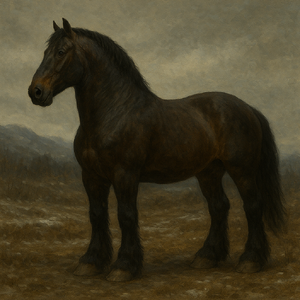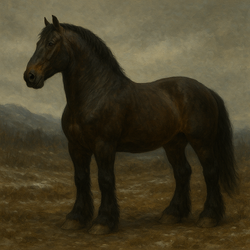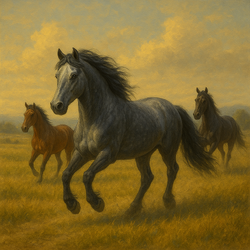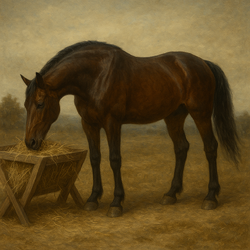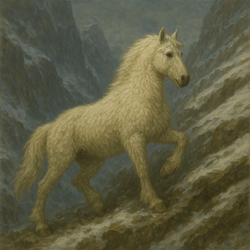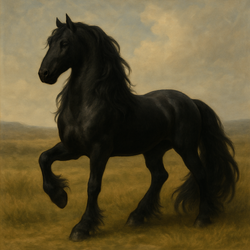Horse: Difference between revisions
(Ragnio moved page Horse to Horse - 1.0 Version) Tag: New redirect |
(Removed redirect to Horse - 1.0 Version) Tag: Removed redirect |
||
| Line 1: | Line 1: | ||
# | {{Infotable Creature | ||
|Image = Northlander Horse.png | |||
|Name = Horse | |||
|Classification = 𐂂 - Beast - Hoofed Mammal | |||
|Rarity = ★☆☆☆☆ - Common | |||
|Scale = ♜♜♜♜♖ - Large | |||
|Nicknames = <br> • Steed <br> • Mount <br> • Stallion | |||
|Habitat = Plains, steppes, forests, mountains, and river valleys | |||
|Height = 1.47 - 1.83 m | |||
|Weight = 500 kg | |||
}}In Eldland, no creature shapes the affairs of men so greatly as the horse. From the thundering charge of armoured knights to the quiet tread of a merchant’s packhorse, these beasts carry war, trade, and travel upon their backs. A fine steed is a treasure equal to gold, a token of nobility, and a weapon of war in its own right. Whole bloodlines are guarded like dynasties, with foals exchanged as dowries or held as ransom. To walk without a horse is to move at the pace of peasants; to ride one is to command the speed, strength, and spirit that built kingdoms. But also to destroy them. | |||
As for its meat, depending on the culture or region, horseflesh can be seen as a common item on the market. Horse meat is seldom eaten in Eldland, as horses are an integral part of society. Yet in times of famine, siege, or long war, men turn to it out of necessity. Their hide is used for leathercrafts, though not as favoured as cow leather. | |||
== Physical Appearance == | |||
The horses of Eldland are as varied as the realms they serve. Most share broad chests, long limbs, and coats that thicken with the seasons. Their colours run from bay and chestnut to grey, black, and roan, with white markings often read as signs of luck or divine favour. | |||
While there are dozens of breeds spread around Eldland, not including those outside the far reaches of the mountain ranges, there are a distinct few that are used primarily within the formed realms of man. Every breed has its own distinct appearance and characteristics that set it apart from others. | |||
=== Northlander === | |||
The Northlander is among the largest of Eldland's horses, standing taller and weighing more than other breeds. Its broad chest, deep barrel, and powerful hindquarters enable it to carry armoured riders without strain. The neck is thick and arched, often with a short, coarse mane. Legs are heavy-boned with broad hooves and feathering around the fetlocks, making them well-adapted for cold and muddy ground, dominantly present in Chyornava. The most common colours are black, bay, or chestnut, with lighter shades being rare. The Northlander is a favoured warhorse among the knights of the northern regions of Eldland and the Kingdom of Reinar. | |||
=== Narathusian === | |||
Narathusians are among the most striking of Eldland's breeds, with noble, arched necks, finely sculpted heads, and flowing manes and tails that are often allowed to grow long. Medium in size, yet deceptively robust, their compact frame and strong hindquarters give them both balance and agility. Their movements are naturally collected, almost like a dancer's steps, with high carriage and a fluid grace that makes them favoured in ceremony as much as in war. Common colours include grey, bay, and black, their coats carrying a subtle sheen in sunlight that enhances their regal appearance. These horses are known as the embodiment of freedom in the south, with a large part of their breed still thriving as wild creatures across the stunning landscapes of Narath. | |||
=== Reinarian Thoroughbred === | |||
The Reinarian Thoroughbred is a tall and finely built breed, characterised by long, slender legs, a deep chest, and lean muscles that suggest speed and endurance. Their heads are narrow and elegant, with keen eyes and flared nostrils that reveal their fiery energy. Their coats vary widely—bay, chestnut, black, and grey are standard—and often gleam with a fine polish under good care. Their movements are long-striding and smooth, carrying them across great distances with tireless grace. They are perhaps the most refined generalist breed in Eldland, bred for versatility as much as appearance. They also come with the reputation of being one of the fastest horses of the mainland, making it a common steed for knights, couriers, and merchants alike who prefer speed and stamina for work or warfare. | |||
=== Karazian White Mountaineer === | |||
The Karazian White Mountaineer, often shortened to Karazian Mountaineer or just Mountaineer, is smaller and more compact than most Eldland breeds, though still tall enough to be a true horse rather than a pony. They are uniquely pale-coated, ranging from snowy white to dappled silver-grey, with thick winter pelts that shed heavily in summer. Due to their unique pale colours, the Karazian Mountaineer often blends into the snowy mountain environment, providing natural camouflage. Their manes and tails grow dense and full, offering warmth in the cold peaks. Their legs are shorter but immensely strong, with hooves as hard as stone, adapted to scramble across jagged cliffs and uneven trails where no other steed dares to tread. This ability is thanks to a unique feature only the Mountaineer has: it has a split hoof, which forms two toes that give it the ability to traverse cliffs and rocky areas with ease, thanks to its grip. They are further characterised by their pointed ears, which make them easily distinguishable. These horses are prized for their endurance, calm nature, and ability to traverse mountainous terrain that is impassable to others. Because of their smaller size, strength, and durability, they are favoured by the Denur who inhabit these regions. | |||
=== Crowned Corvaeld === | |||
The Crowned Corvaeld, home to the more southern regions of the Crownlands and the edges of the Morvain swamps, is tall, striking, and unmistakable. Their long, arching necks carry proud heads framed by thick, flowing manes that tumble nearly to their shoulders. Their tails are equally long and full, giving them a regal presence in both parade and battlefield. Their coats are almost always a glossy black, deep as midnight, lending to their reputation for elegance and power. Their high-stepping gait sets them apart, moving with a natural grandeur that few other breeds can match. It is a known fact that the Corvaeld traces its bloodline back to Dôk-Myr, the accursed lands, where their ancestors moved to the Crownlands after the downfall of this ancient realm. It is the second most common knightly mount in the Kingdom of Reinar, valued for presence, endurance, and disciplined behaviour in both war and parade. | |||
{| class="wikitable mw-collapsible" width=50% style="margin-left: auto; margin-right: auto; width=200px; background:#EDE2C5;" | |||
!colspan="1" span style="background:#b88c8c; color:#000; text-align:center; vertical-align:middle;"|Horses of Eldland | |||
|- style="background:#D0D3D4; text-align:center; vertical-align:center;" | |||
|- style="vertical-align:middle;" | |||
| style="background:#EDE2C5;" valign="center"| | |||
{| width=100% style="border:10px; background:#EDE2C5; float:left;" | |||
|- colspan="5" class="wikitable" style="background:#b88c8c; text-align:center; margin-left: 5px;" | |||
|- | |||
|! colspan="1" span width=20% style="border-right:1px dotted #aaa; text-align:center; vertical-align:top; font-size:Medium;" | [[File:Northlander Horse.png|250px]] | |||
|style="border-right:1px dotted #aaa; text-align:center; vertical-align:top; font-size:Medium;" | [[File:Narathusian Horse.png|250px]] | |||
|style="border-right:1px dotted #aaa; text-align:center; vertical-align:top; font-size:Medium;" | [[File:Reinarian Horse.png|250px]] | |||
|style="border-right:1px dotted #aaa; text-align:center; vertical-align:top; font-size:Medium;" | [[File:Mountaineer Horse.png|250px]] | |||
|style="text-align:center; vertical-align:top; font-size:Medium;" | [[File:Crowned Horse.png|250px]] | |||
|- | |||
|- colspan="5" class="wikitable" style="background:#b88c8c; text-align:center; margin-left: 5px;" | |||
! colspan="5" span style="font-size:Medium;"| | |||
|- | |||
|! colspan="1" span width=25% style="border-right:1px dotted #aaa; text-align:center; vertical-align:top; font-size:Medium;" | '''Northlander''' | |||
|style="border-right:1px dotted #aaa; text-align:center; vertical-align:top; font-size:Medium;" | '''Narathusian''' | |||
|style="border-right:1px dotted #aaa; text-align:center; vertical-align:top; font-size:Medium;" | '''Reinarian Thoroughbred''' | |||
|style="border-right:1px dotted #aaa; text-align:center; vertical-align:top; font-size:Medium;" | '''Karazian White Mountaineer''' | |||
|style="text-align:center; vertical-align:top; font-size:Medium;" | '''Crowned Corvaeld''' | |||
|} | |||
|} | |||
== Mental Characteristics == | |||
Horses are quick-witted prey animals, shaped by constant watchfulness. Their first instinct is to flee, but when cornered, they kick and strike with surprising ferocity. They read the moods of herd-mates and handlers alike, and their sharp memory allows them to recall paths, scents, and even faces long after first meeting. In the wild, they maintain constant awareness, resting only in turns so that part of the herd is always alert. Mutual grooming—nuzzling, rubbing, or chewing at each other's coats—is common among bonded pairs and serves as a mark of trust. Herd bonds are deeply felt, and separation often brings distress. This same nature explains their loyalty in domestication: once a horse comes to see a rider as part of its herd, the bond can last a lifetime. Whenever its rider experiences feelings of distress, fear, exhilaration, or relaxation, the steed mirrors those emotions, sensing them through the rhythmic pulse of the caretaker's heart. This deep connection allows the horse to intuitively understand and share in the rider's emotional journey, creating an unbreakable bond between them. It is known that horses are keen and perceptive, with instincts that have carried them through centuries of predation. However, cruelty breeds fear that no reins can hide. | |||
=== Northlander === | |||
Northlanders are noted for steadiness under duress. They remain calm in loud and chaotic environments, making them reliable in battle. Slow to trust new handlers, but once bonded, they obey consistently. They are less quick to react than lighter breeds, sometimes perceived as stubborn, though this makes them less prone to panic. | |||
=== Narathusian === | |||
Highly intelligent and quick to learn. Sensitive to the rider's commands and capable of subtle responsiveness. They are spirited and proud, often requiring an experienced hand to maintain discipline. Known for their strong memory and ability to form deep bonds with riders. In inexperienced hands, they can become headstrong and difficult, and are often a risk for those attempting to tame a Narathusian in the wild for their restless nature. | |||
=== Reinarian Thoroughbred === | |||
Energetic and restless by nature, Thoroughbreds require regular activity. They are quick to react and often spirited, traits that make them fast but sometimes difficult for unskilled riders. Strong-willed but loyal when well-trained. Their endurance and eagerness make them versatile, though poor handling can result in nervous or excitable temperaments. | |||
=== Karazian White Mountaineer === | |||
Cautious and deliberate, the Mountaineer is rarely startled by sudden noises or movements. They are patient animals, capable of enduring long marches or climbs without faltering. Less fiery and spirited than other breeds, but highly dependable. Tend toward loyalty when handled kindly, though they are not naturally eager or playful. The Mountaineer is little shaken by storms, rockfalls, or the cry of wolves in the night. | |||
=== Crowned Corvaeld === | |||
A horse known for its calmness, patience, and steadiness under stress. Intelligent and observant, with a tendency to be wary of unfamiliar situations. They do not spook easily and are less spirited than southern breeds, but this makes them reliable in prolonged use. Known to form long-lasting bonds with riders. Some horses are specifically bred and trained to develop distinct characters, enabling them to experience the civilised world more naturally. | |||
== Lifespan and Development == | |||
The young of a horse, known as foals, are born after nearly a year's gestation, in the safety of spring when grass is plentiful. They can stand and walk within hours, for a weak foal soon falls prey to predators. In the wild, foals stay pressed to their dams, which are their mothers, and learn to follow the rhythm of the herd. By their second year, young colts begin to challenge each other in mock battles, biting and rearing to test their strength, while fillies form close bonds within the mare's circle. Stallions are usually driven out before their third year, forced to wander until they can claim mares of their own or gather a small following. Life in the wild is harsh: broken bones or winter starvation often cut lives short, and few survive beyond twenty years. Under the hand of man, however, they may live longer. | |||
Whenever a horse is captured from the wild or raised by farmers, it will face its true breaking and training in the third spring, when strength and spirit are sufficient for saddle and bridle. Most warhorses serve between 5 and 15 years before strain takes its toll. Hardy labouring breeds may give service for two decades. The inhabitants of Eldland have taken a closer look at the various horse breeds and have found ways to tame, breed, and utilise specific breeds for specific tasks. | |||
The Narathusian, bred for versatility, often remains useful for longer than the Thoroughbred but is usually too unpredictable whenever facing dangerous situations such as combat. The Mountaineer, shaped by hardship, can labour far into old age without faltering. Average lifespan ranges from 25 to 30 years. Such longevity is rare outside noble studs and temple stables, where horses are spared the burdens of war. Elder horses grow grey around the muzzle and slower in gait. Many keep a certain fire in the eye until their last days. | |||
== Territory and Grouping == | |||
Wild horses move in tight-knit herds led by a dominant mare, who decides where to graze, drink, or flee. The stallion lingers at the edge of the group, defending against predators or rival males. Herds are ever-moving, seldom lingering long in one place, for overgrazed pasture quickly weakens them. On open plains, herds can swell to dozens, flowing across the grass like rivers, while in the mountains or forests, they gather in smaller bands to better navigate difficult ground. Narathusians, for example, wander the vast southern plains and coasts, their grace born from centuries of free-running herds. At the same time, the Karazian White Mountaineers gather in small, tight-knit bands, navigating treacherous cliffs where no army dares to follow. This protects them from civilisation and hunters. Their society is ordered but fluid—when danger looms, all move as one, and when food is scarce, weaker members, or those that are unable to follow the larger herd, may drift away to join other groups. | |||
Even when domesticated, this instinct remains. Horses grow restless if stabled alone, neighing and kicking until they are placed near others. Familiar companions soothe them and often form lifelong attachments. Many riders have told of their horses refusing to leave fallen comrades—be they horse or man—showing the deep herd-bond that governs their hearts. | |||
Among men, horses are wealth and power. A knight's worth is tied to his steed, a merchant's fortune to his pack train, and a lord's prestige to his breeding stables. Lineages are kept as carefully as noble blood, foals exchanged as dowries, bribes, or royal gifts. Wild herds are rare beyond the far south and deep mountains, for most horses are too precious to leave unclaimed. Yet wherever they run free—whether the Narathusian bands of the south or the pale Mountaineers upon the heights—they remain symbols of freedom untamed by bridle or spur. | |||
== Abilities == | |||
The horse is a beast of remarkable swiftness and strength, able to outpace wolf and man alike with its gallop. Few creatures of its size can match its endurance, for a steady mount may carry rider and burden across leagues of open country in a single day. When roused to violence, a horse is no mere docile servant: the kick of its hind legs can shatter bone, the strike of its forehooves can fell a man. The greatest strength of any horse is their numbers. The sheer weight of its charge, with the ground shaking underneath, is enough to instil fear in the hearts of man and predator. | |||
Its senses are ever sharp. With wide eyes, keen ears, and an acute sense of smell, the horse perceives danger before most men are aware of it. This caution is both a strength and a weakness, for the same instincts that preserve it in the wild may turn to panic when fire, steel, or sudden noise fills the air. Yet, when properly trained—and when the bond with its rider is true—this natural fear can be steadied into courage. | |||
The breeds of Eldland reveal their gifts most clearly in the field. All breeds around Eldland possess abilities naturally acquired in the wild, while others were developed through breeding and training. | |||
For all their might, horses remain bound by certain limits. Their speed cannot be held for long, their slender legs are easily lamed, and their hides offer little defence against arrow or blade. They are prey-born creatures, ever watchful, and though some will stand firm beside their riders, others will flee the field if fear takes them. | |||
{{Navtable Creatures}} | |||
<noinclude>[[Category:Bestiary]]</noinclude> | |||
__NOTOC__ | |||
Latest revision as of 18:53, 3 October 2025
| Horse | |||||||||
|---|---|---|---|---|---|---|---|---|---|
| |||||||||
In Eldland, no creature shapes the affairs of men so greatly as the horse. From the thundering charge of armoured knights to the quiet tread of a merchant’s packhorse, these beasts carry war, trade, and travel upon their backs. A fine steed is a treasure equal to gold, a token of nobility, and a weapon of war in its own right. Whole bloodlines are guarded like dynasties, with foals exchanged as dowries or held as ransom. To walk without a horse is to move at the pace of peasants; to ride one is to command the speed, strength, and spirit that built kingdoms. But also to destroy them.
As for its meat, depending on the culture or region, horseflesh can be seen as a common item on the market. Horse meat is seldom eaten in Eldland, as horses are an integral part of society. Yet in times of famine, siege, or long war, men turn to it out of necessity. Their hide is used for leathercrafts, though not as favoured as cow leather.
Physical Appearance
The horses of Eldland are as varied as the realms they serve. Most share broad chests, long limbs, and coats that thicken with the seasons. Their colours run from bay and chestnut to grey, black, and roan, with white markings often read as signs of luck or divine favour.
While there are dozens of breeds spread around Eldland, not including those outside the far reaches of the mountain ranges, there are a distinct few that are used primarily within the formed realms of man. Every breed has its own distinct appearance and characteristics that set it apart from others.
Northlander
The Northlander is among the largest of Eldland's horses, standing taller and weighing more than other breeds. Its broad chest, deep barrel, and powerful hindquarters enable it to carry armoured riders without strain. The neck is thick and arched, often with a short, coarse mane. Legs are heavy-boned with broad hooves and feathering around the fetlocks, making them well-adapted for cold and muddy ground, dominantly present in Chyornava. The most common colours are black, bay, or chestnut, with lighter shades being rare. The Northlander is a favoured warhorse among the knights of the northern regions of Eldland and the Kingdom of Reinar.
Narathusian
Narathusians are among the most striking of Eldland's breeds, with noble, arched necks, finely sculpted heads, and flowing manes and tails that are often allowed to grow long. Medium in size, yet deceptively robust, their compact frame and strong hindquarters give them both balance and agility. Their movements are naturally collected, almost like a dancer's steps, with high carriage and a fluid grace that makes them favoured in ceremony as much as in war. Common colours include grey, bay, and black, their coats carrying a subtle sheen in sunlight that enhances their regal appearance. These horses are known as the embodiment of freedom in the south, with a large part of their breed still thriving as wild creatures across the stunning landscapes of Narath.
Reinarian Thoroughbred
The Reinarian Thoroughbred is a tall and finely built breed, characterised by long, slender legs, a deep chest, and lean muscles that suggest speed and endurance. Their heads are narrow and elegant, with keen eyes and flared nostrils that reveal their fiery energy. Their coats vary widely—bay, chestnut, black, and grey are standard—and often gleam with a fine polish under good care. Their movements are long-striding and smooth, carrying them across great distances with tireless grace. They are perhaps the most refined generalist breed in Eldland, bred for versatility as much as appearance. They also come with the reputation of being one of the fastest horses of the mainland, making it a common steed for knights, couriers, and merchants alike who prefer speed and stamina for work or warfare.
Karazian White Mountaineer
The Karazian White Mountaineer, often shortened to Karazian Mountaineer or just Mountaineer, is smaller and more compact than most Eldland breeds, though still tall enough to be a true horse rather than a pony. They are uniquely pale-coated, ranging from snowy white to dappled silver-grey, with thick winter pelts that shed heavily in summer. Due to their unique pale colours, the Karazian Mountaineer often blends into the snowy mountain environment, providing natural camouflage. Their manes and tails grow dense and full, offering warmth in the cold peaks. Their legs are shorter but immensely strong, with hooves as hard as stone, adapted to scramble across jagged cliffs and uneven trails where no other steed dares to tread. This ability is thanks to a unique feature only the Mountaineer has: it has a split hoof, which forms two toes that give it the ability to traverse cliffs and rocky areas with ease, thanks to its grip. They are further characterised by their pointed ears, which make them easily distinguishable. These horses are prized for their endurance, calm nature, and ability to traverse mountainous terrain that is impassable to others. Because of their smaller size, strength, and durability, they are favoured by the Denur who inhabit these regions.
Crowned Corvaeld
The Crowned Corvaeld, home to the more southern regions of the Crownlands and the edges of the Morvain swamps, is tall, striking, and unmistakable. Their long, arching necks carry proud heads framed by thick, flowing manes that tumble nearly to their shoulders. Their tails are equally long and full, giving them a regal presence in both parade and battlefield. Their coats are almost always a glossy black, deep as midnight, lending to their reputation for elegance and power. Their high-stepping gait sets them apart, moving with a natural grandeur that few other breeds can match. It is a known fact that the Corvaeld traces its bloodline back to Dôk-Myr, the accursed lands, where their ancestors moved to the Crownlands after the downfall of this ancient realm. It is the second most common knightly mount in the Kingdom of Reinar, valued for presence, endurance, and disciplined behaviour in both war and parade.
| Horses of Eldland | |||||||||||||||
|---|---|---|---|---|---|---|---|---|---|---|---|---|---|---|---|
| |||||||||||||||
Mental Characteristics
Horses are quick-witted prey animals, shaped by constant watchfulness. Their first instinct is to flee, but when cornered, they kick and strike with surprising ferocity. They read the moods of herd-mates and handlers alike, and their sharp memory allows them to recall paths, scents, and even faces long after first meeting. In the wild, they maintain constant awareness, resting only in turns so that part of the herd is always alert. Mutual grooming—nuzzling, rubbing, or chewing at each other's coats—is common among bonded pairs and serves as a mark of trust. Herd bonds are deeply felt, and separation often brings distress. This same nature explains their loyalty in domestication: once a horse comes to see a rider as part of its herd, the bond can last a lifetime. Whenever its rider experiences feelings of distress, fear, exhilaration, or relaxation, the steed mirrors those emotions, sensing them through the rhythmic pulse of the caretaker's heart. This deep connection allows the horse to intuitively understand and share in the rider's emotional journey, creating an unbreakable bond between them. It is known that horses are keen and perceptive, with instincts that have carried them through centuries of predation. However, cruelty breeds fear that no reins can hide.
Northlander
Northlanders are noted for steadiness under duress. They remain calm in loud and chaotic environments, making them reliable in battle. Slow to trust new handlers, but once bonded, they obey consistently. They are less quick to react than lighter breeds, sometimes perceived as stubborn, though this makes them less prone to panic.
Narathusian
Highly intelligent and quick to learn. Sensitive to the rider's commands and capable of subtle responsiveness. They are spirited and proud, often requiring an experienced hand to maintain discipline. Known for their strong memory and ability to form deep bonds with riders. In inexperienced hands, they can become headstrong and difficult, and are often a risk for those attempting to tame a Narathusian in the wild for their restless nature.
Reinarian Thoroughbred
Energetic and restless by nature, Thoroughbreds require regular activity. They are quick to react and often spirited, traits that make them fast but sometimes difficult for unskilled riders. Strong-willed but loyal when well-trained. Their endurance and eagerness make them versatile, though poor handling can result in nervous or excitable temperaments.
Karazian White Mountaineer
Cautious and deliberate, the Mountaineer is rarely startled by sudden noises or movements. They are patient animals, capable of enduring long marches or climbs without faltering. Less fiery and spirited than other breeds, but highly dependable. Tend toward loyalty when handled kindly, though they are not naturally eager or playful. The Mountaineer is little shaken by storms, rockfalls, or the cry of wolves in the night.
Crowned Corvaeld
A horse known for its calmness, patience, and steadiness under stress. Intelligent and observant, with a tendency to be wary of unfamiliar situations. They do not spook easily and are less spirited than southern breeds, but this makes them reliable in prolonged use. Known to form long-lasting bonds with riders. Some horses are specifically bred and trained to develop distinct characters, enabling them to experience the civilised world more naturally.
Lifespan and Development
The young of a horse, known as foals, are born after nearly a year's gestation, in the safety of spring when grass is plentiful. They can stand and walk within hours, for a weak foal soon falls prey to predators. In the wild, foals stay pressed to their dams, which are their mothers, and learn to follow the rhythm of the herd. By their second year, young colts begin to challenge each other in mock battles, biting and rearing to test their strength, while fillies form close bonds within the mare's circle. Stallions are usually driven out before their third year, forced to wander until they can claim mares of their own or gather a small following. Life in the wild is harsh: broken bones or winter starvation often cut lives short, and few survive beyond twenty years. Under the hand of man, however, they may live longer.
Whenever a horse is captured from the wild or raised by farmers, it will face its true breaking and training in the third spring, when strength and spirit are sufficient for saddle and bridle. Most warhorses serve between 5 and 15 years before strain takes its toll. Hardy labouring breeds may give service for two decades. The inhabitants of Eldland have taken a closer look at the various horse breeds and have found ways to tame, breed, and utilise specific breeds for specific tasks.
The Narathusian, bred for versatility, often remains useful for longer than the Thoroughbred but is usually too unpredictable whenever facing dangerous situations such as combat. The Mountaineer, shaped by hardship, can labour far into old age without faltering. Average lifespan ranges from 25 to 30 years. Such longevity is rare outside noble studs and temple stables, where horses are spared the burdens of war. Elder horses grow grey around the muzzle and slower in gait. Many keep a certain fire in the eye until their last days.
Territory and Grouping
Wild horses move in tight-knit herds led by a dominant mare, who decides where to graze, drink, or flee. The stallion lingers at the edge of the group, defending against predators or rival males. Herds are ever-moving, seldom lingering long in one place, for overgrazed pasture quickly weakens them. On open plains, herds can swell to dozens, flowing across the grass like rivers, while in the mountains or forests, they gather in smaller bands to better navigate difficult ground. Narathusians, for example, wander the vast southern plains and coasts, their grace born from centuries of free-running herds. At the same time, the Karazian White Mountaineers gather in small, tight-knit bands, navigating treacherous cliffs where no army dares to follow. This protects them from civilisation and hunters. Their society is ordered but fluid—when danger looms, all move as one, and when food is scarce, weaker members, or those that are unable to follow the larger herd, may drift away to join other groups.
Even when domesticated, this instinct remains. Horses grow restless if stabled alone, neighing and kicking until they are placed near others. Familiar companions soothe them and often form lifelong attachments. Many riders have told of their horses refusing to leave fallen comrades—be they horse or man—showing the deep herd-bond that governs their hearts.
Among men, horses are wealth and power. A knight's worth is tied to his steed, a merchant's fortune to his pack train, and a lord's prestige to his breeding stables. Lineages are kept as carefully as noble blood, foals exchanged as dowries, bribes, or royal gifts. Wild herds are rare beyond the far south and deep mountains, for most horses are too precious to leave unclaimed. Yet wherever they run free—whether the Narathusian bands of the south or the pale Mountaineers upon the heights—they remain symbols of freedom untamed by bridle or spur.
Abilities
The horse is a beast of remarkable swiftness and strength, able to outpace wolf and man alike with its gallop. Few creatures of its size can match its endurance, for a steady mount may carry rider and burden across leagues of open country in a single day. When roused to violence, a horse is no mere docile servant: the kick of its hind legs can shatter bone, the strike of its forehooves can fell a man. The greatest strength of any horse is their numbers. The sheer weight of its charge, with the ground shaking underneath, is enough to instil fear in the hearts of man and predator.
Its senses are ever sharp. With wide eyes, keen ears, and an acute sense of smell, the horse perceives danger before most men are aware of it. This caution is both a strength and a weakness, for the same instincts that preserve it in the wild may turn to panic when fire, steel, or sudden noise fills the air. Yet, when properly trained—and when the bond with its rider is true—this natural fear can be steadied into courage.
The breeds of Eldland reveal their gifts most clearly in the field. All breeds around Eldland possess abilities naturally acquired in the wild, while others were developed through breeding and training.
For all their might, horses remain bound by certain limits. Their speed cannot be held for long, their slender legs are easily lamed, and their hides offer little defence against arrow or blade. They are prey-born creatures, ever watchful, and though some will stand firm beside their riders, others will flee the field if fear takes them.
| Navigation - Animals & Creatures | ||||||||||||||||||
|---|---|---|---|---|---|---|---|---|---|---|---|---|---|---|---|---|---|---|
| ||||||||||||||||||
